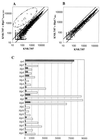Microarray-based identification of a novel Streptococcus pneumoniae regulon controlled by an autoinduced peptide
- PMID: 10940007
- PMCID: PMC111343
- DOI: 10.1128/JB.182.17.4696-4703.2000
Microarray-based identification of a novel Streptococcus pneumoniae regulon controlled by an autoinduced peptide
Abstract
We have identified in the Streptococcus pneumoniae genome sequence a two-component system (TCS13, Blp [bacteriocin-like peptide]) which is closely related to quorum-sensing systems regulating cell density-dependent phenotypes such as the development of genetic competence or the production of antimicrobial peptides in lactic acid bacteria. In this study we present evidence that TCS13 is a peptide-sensing system that controls a regulon including genes encoding Blps. Downstream of the Blp TCS (BlpH R) we identified open reading frames (blpAB) that have the potential to encode an ABC transporter that is homologous to the ComA/B export system for the competence-stimulating peptide ComC. The putative translation product of blpC, a small gene located downstream of blpAB, has a leader peptide with a Gly-Gly motif. This leader peptide is typical of precursors processed by this family of transporters. Microarray-based expression profiling showed that a synthetic oligopeptide corresponding to the processed form of BlpC (BlpC*) induces a distinct set of 16 genes. The changes in the expression profile elicited by synthetic BlpC* depend on BlpH since insertional inactivation of its corresponding gene abolishes differential gene induction. Comparison of the promoter regions of the blp genes disclosed a conserved sequence element formed by two imperfect direct repeats upstream of extended -10 promoter elements. We propose that BlpH is the sensor for BlpC* and the conserved sequence element is a recognition sequence for the BlpR response regulator.
Figures






References
-
- Aaberge L S, Eng J, Lermark G, Lovik M. Virulence of Streptococcus pneumoniae in mice: a standardized method for preparation and frozen storage of the experimental bacterial inoculum. Microb Pathog. 1995;18:141–152. - PubMed
-
- Atherton E, Sheppard R. Solid phase peptide synthesis: a practical approach. Oxford, United Kingdom: IRL Press; 1989.
-
- Brurberg M B, Nes I F, Eijsink V G. Pheromone-induced production of antimicrobial peptides in Lactobacillus. Mol Microbiol. 1997;26:347–360. - PubMed
-
- Canvin J R, Paton J C, Boulnois G J, Andrew P W, Mitchell T J. Streptococcus pneumoniae produces a second haemolysin that is distinct from pneumolysin. Microb Pathog. 1997;22:129–132. - PubMed
MeSH terms
Substances
Associated data
- Actions
LinkOut - more resources
Full Text Sources
Other Literature Sources
Molecular Biology Databases

